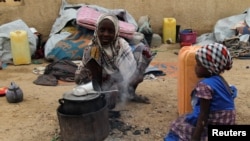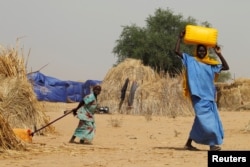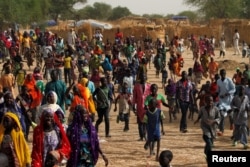The Boko Haram militant group's insurgency has forced nearly 300,000 people to seek refuge in the Diffa region of southeast Niger, an area already dealing with chronic food insecurity. Aid agencies are struggling to provide adequate water and food to tens of thousands of people who fled a fresh attack in the border town of Bosso this month.
Every day it's the same snaking line of people holding yellow water containers at one of the few taps available in Kidjendi, a camp located about 40 kilometers from Diffa, in southeast Niger.
Cheldou Malou lives at the camp with seven relatives.
She said there are a lot of people. Sometimes they bring two containers but only fill one. She says she comes in the morning but doesn't get enough water, so she has to come back for more in the afternoon.
Malou and her family are among an estimated 50,000 people who fled the area around the border town of Bosso following a Boko Haram attack June 3.
Many left everything behind and walked on foot for several days before gathering in camps in the desert. They built makeshift shelters out of straw and plastic covers donated by non-governmental organizations. The structures are at risk of flying away with each wind gust.
Kidjendi alone has about 40,000 refugees and internally displaced people.
The head of Doctors Without Borders - Spain (MSF-Spain) in Niger, Elmounzer AG Jiddou, said there is not enough water.
He said the situation they are in at the moment can create conflict because the amount of water they receive is not enough, given the current temperatures.
A few days ago, a fight by a watering hole in Kidjendi left one person dead.
Some displaced farmers managed to flee with livestock, and the cows and donkeys now roaming the camp are another source of tension.
Food is scarce.
One mother, Yamgana Goni, said she has no food or shelter; nothing, and fears her nine children will die of hunger.
Aid workers say the key to better assistance is security.
Despite the increased military presence, Boko Haram continues carrying out sporadic attacks in the area, so people keep moving around, making the receipt of aid difficult.
OCHA coordinator Fodé N’Diaye said for wells to be drilled, the work has to be done on sites that are stabilized.
Diffa was already hosting about 240,000 refugees and displaced people when Bosso was attacked. The influx of more internally displaced persons has strained resources further.
The U.N. children's fund's (UNICEF’s) water manager, Mohamed Ali, said providing such a large amount of water is very expensive and that resources likely will run out in a few weeks. He says more will be needed.
MSF’s Jiddou said the threat of attack is also preventing aid agencies from reaching people deeper in the bush.
He said there needs to be a system of coordination so that actions can focus on the most vulnerable populations and the government will need to lead that effort.
Interior Minister Mohamed Bazoum visited the camps last week to bring food aid and reassure the population.
Aid agencies warn that the humanitarian crisis could continue to spread in the region around Lake Chad.











